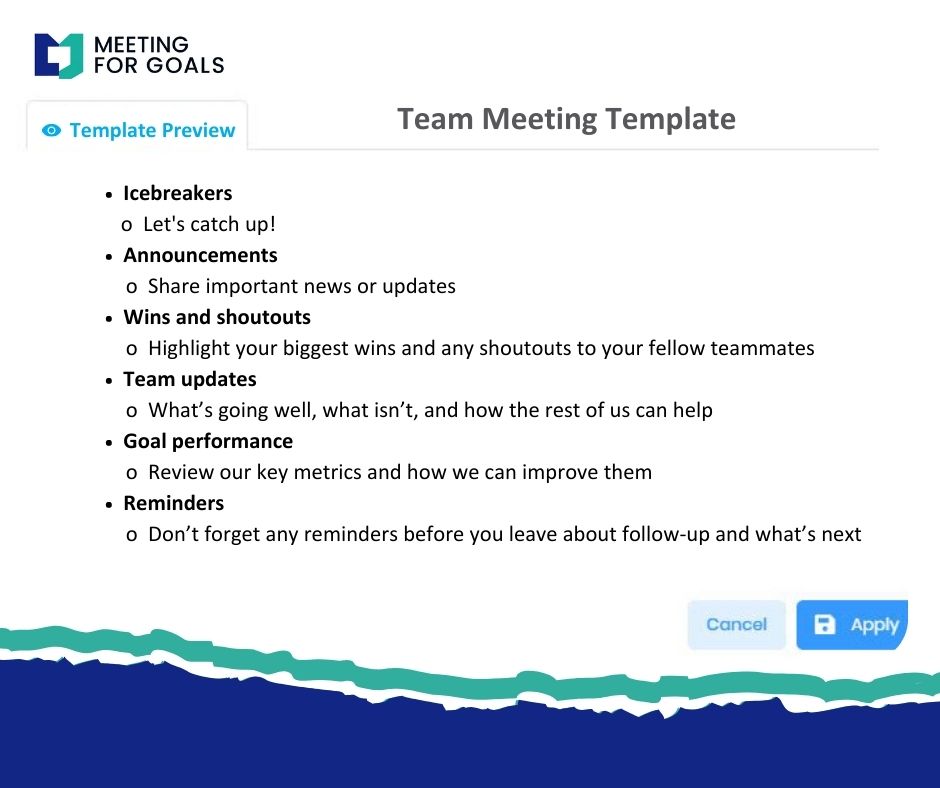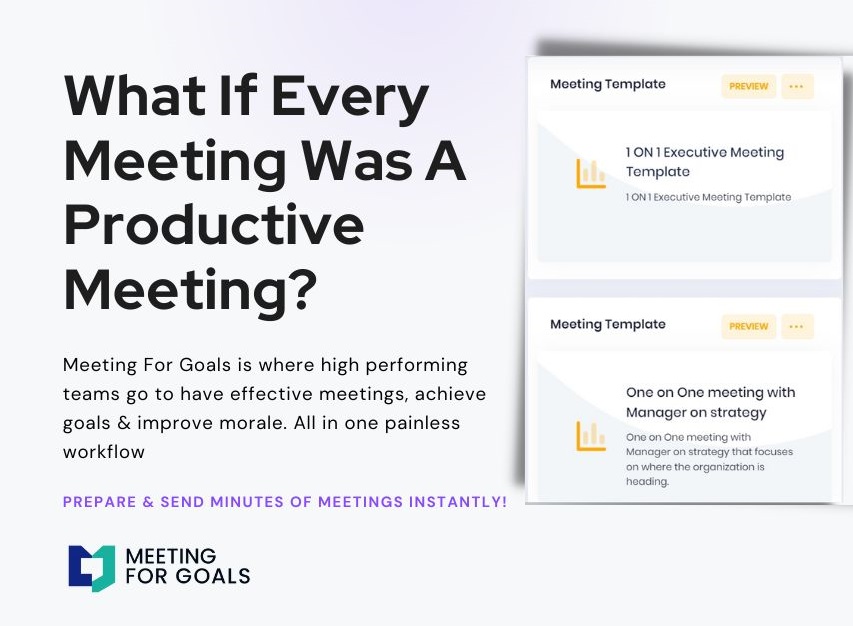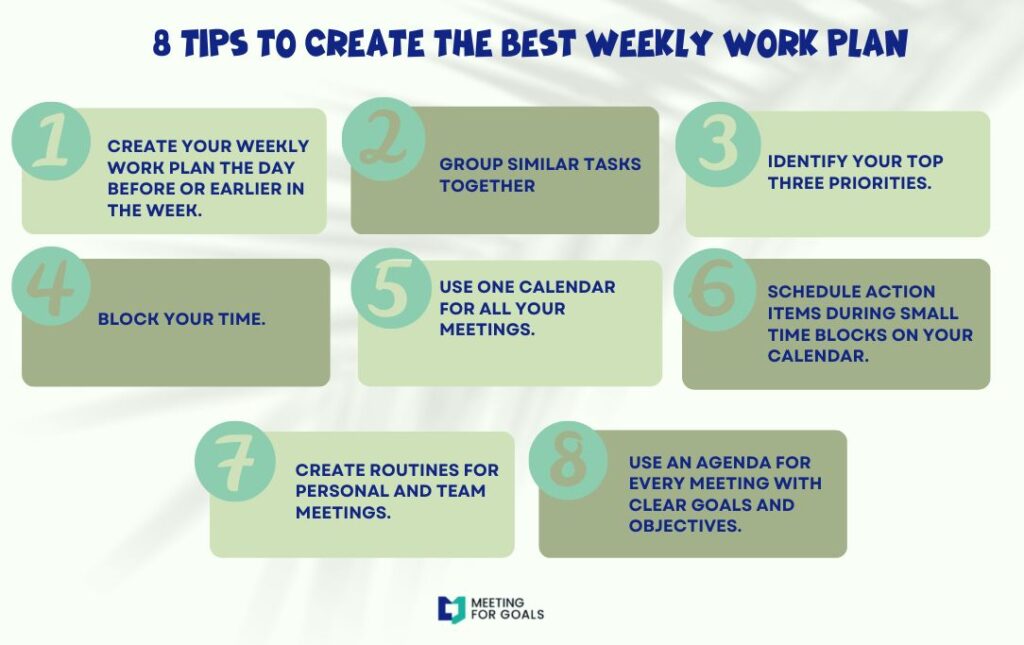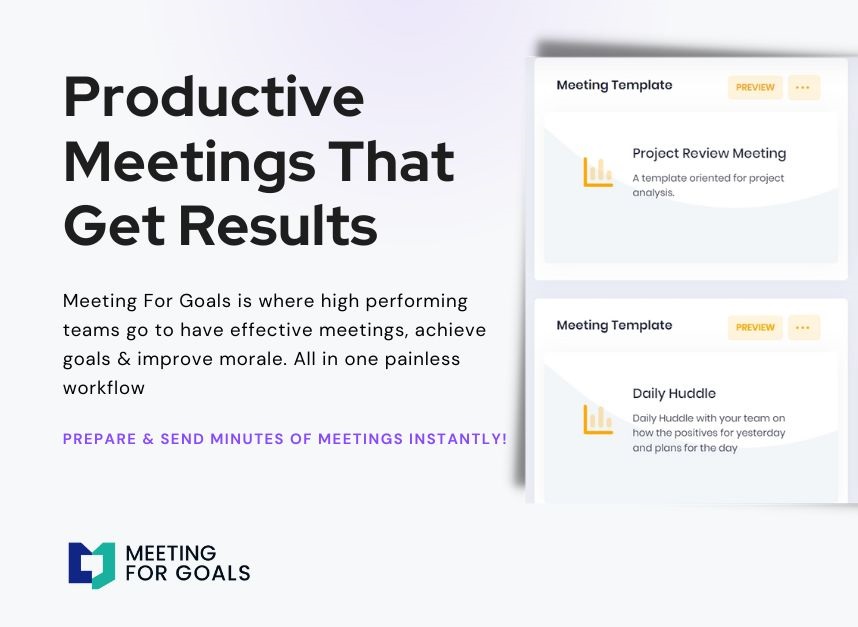Achieve Extraordinary Results with Effective Meeting Management
I. Introduction
Let’s face it—meetings can either be your team’s biggest asset or its biggest time-waster. If you’re leading a mid-sized company with 40 to 70 employees, chances are you’ve experienced both sides. For executives like VPs, Directors, and C-suite leaders, unproductive meetings don’t just cost time—they cost momentum, morale, and money.
But here’s the good news: it doesn’t have to be that way. With the right approach and tools, meetings can fuel innovation, boost accountability, and keep your team aligned with your company’s goals. That’s where effective meeting management comes in.
In this guide, we’ll break down how you can take control of your meetings, avoid common pitfalls, and use smart tools like Meeting For Goals to turn every meeting into a strategic win. Whether you’re looking to streamline weekly check-ins or eliminate status meetings that go nowhere, we’ve got you covered.
Ready to get more out of your meetings? Start by exploring our free meeting templates to kickstart your transformation: https://meetingforgoals.com/meeting_templates.
2 Minute Video
Watch a 2 minute demo of our meeting management software in action
II. Understanding the Impact of Meetings on Team Productivity
Meetings are essential. They bring people together to make decisions, solve problems, and align on goals. However, when they’re not managed well, they can become a serious drain on productivity.
According to a Harvard Business Review study, executives now spend nearly 23 hours a week in meetings—more than double what they did in the 1960s. Even worse? Over 70% of those meetings are considered unproductive.
For mid-sized companies, this inefficiency adds up fast. Imagine a team of 50 employees sitting through an hour-long meeting that doesn’t lead to action. That’s 50 hours lost—every single time.
Common issues include:
- No clear agenda or purpose
- Poor time management
- Lack of engagement or participation
- No follow-up or accountability
- Meetings that should’ve been emails
These problems don’t just waste time—they hurt morale. When meetings feel pointless, people tune out. That leads to disengagement, missed goals, and a lack of ownership.
So how do you fix it? Start by using tools designed to make meetings more effective. Meeting For Goals is built specifically for high-performing teams that need to stay focused and aligned. It helps you plan smarter, track progress, and ensure every meeting drives results.
Want to see how it works? Sign up for a free account here: https://app.meetingforgoals.com/TenantRegistration/Register.
Adding an Agenda
How to add an agenda instantly on Meeting For Goals
III. Key Features of Effective Meeting Management Software
Let’s break down what great meeting management software should actually do. Spoiler: it’s not just about scheduling. Meeting For Goals is built to help teams like yours run lean, focused, and results-driven meetings. Here’s what makes it stand out.
- Goal Alignment: Every meeting should connect to a bigger purpose. With Meeting For Goals, you can tie every agenda item to your company’s strategic objectives—like hitting revenue targets, launching a product, or improving customer satisfaction. This keeps conversations focused and ensures that meetings aren’t just routine—they’re results-oriented. Leaders can also track how meetings are contributing to broader goals, which helps in making faster, data-driven decisions.
- Accountability and Task Ownership: How many times have you left a meeting thinking, “Who’s actually doing what?” Meeting For Goals eliminates that ambiguity. It lets you assign tasks in real-time during the meeting, with clear owners and deadlines. Everyone knows what they’re responsible for—and by when. This boosts follow-through, reduces confusion, and creates a culture of accountability.
- Smart Time Management: Time is precious—especially for executives. Meeting For Goals helps you make the most of it with:
- Pre-built agenda templates
- Built-in timers and time-boxing
- Real-time progress tracking
These tools keep meetings tight and on-topic. You’ll spend less time talking in circles and more time moving things forward.
- Integrated Workflow: Meeting For Goals connects with your existing tools—like calendars, project management software, and communication platforms. That means your meeting insights don’t get lost in a notebook or email thread—they’re integrated directly into your team’s workflow. Plus, it stores historical data so you can review past meetings, track trends, and continuously improve.
Want to see how this works in action? Explore our platform features at https://meetingforgoals.com.
IV. Best Practices for Conducting Effective Meetings
Even the best software won’t save a poorly run meeting. To truly transform your meeting culture, you need to follow proven best practices. Here’s a step-by-step look at what works.
- Preparation: Set the Stage for Success. The best meetings start before they even begin.
- Create a Clear Agenda: List topics, assign time limits, and state the expected outcomes. Share it at least 24 hours in advance.
- Define Objectives: What’s the goal of this meeting? Use SMART goals for clarity.
- Invite the Right People: Only include those who are essential to the discussion.
With Meeting For Goals, you can build and share agendas in minutes. This ensures everyone shows up prepared and aligned.
- Execution: Keep Things Focused. Once the meeting starts, it’s all about maintaining momentum.
- Stick to the Agenda: Use timers or a facilitator to keep things moving.
- Encourage Input: Use round-robin formats or ask direct questions to involve everyone.
- Use Tech Wisely: Good audio, video, and screen sharing make a big difference—especially for remote teams.
Meeting For Goals includes real-time note-taking, task assignment, and time tracking—all in one place. That means facilitators can focus on leading the meeting, not juggling tools.
- Follow-Up: Turn Talk into Action. A meeting without follow-up is just talk. Here’s how to make sure things get done.
- Share Meeting Notes: Summarize key takeaways, decisions, and action items.
- Assign Tasks: Be clear about who’s doing what—and when it’s due.
- Track Progress: Use dashboards or follow-up meetings to monitor task completion.
Meeting For Goals automates much of this process. You’ll never lose track of action items again.
Want to start using these best practices today? Check out our free meeting templates at https://meetingforgoals.com/meeting_templates.
V. Real-Life Examples of Successful Meeting Management
Let’s look at how real companies are using Meeting For Goals to improve their meetings—and results.
Case Study 1: Mid-Sized SaaS Company
A 60-person tech firm was drowning in weekly meetings that ran long and lacked follow-through. After switching to Meeting For Goals, they saw:
- A 35% reduction in meeting duration
- A 60% increase in task completion rates
- A jump in meeting satisfaction from 42% to 88%
By aligning meetings with their quarterly OKRs, leadership made faster, more informed decisions—and the team felt more engaged.
Case Study 2: Marketing Agency
A 45-person digital agency used Meeting For Goals to improve accountability in client planning sessions. In just three months:
- Project delivery times improved by 25%
- Missed deadlines dropped by 70%
- Team morale increased due to clear expectations
The software’s task assignment and follow-up features were key to this success.
Case Study 3: Manufacturing Firm
A 70-person manufacturing company used Meeting For Goals to streamline cross-departmental meetings between sales, engineering, and operations. The results?
- 40% fewer meetings without losing communication
- Better coordination on production schedules
- Stronger collaboration across departments
These stories prove that effective meeting management isn’t just a theory—it’s a game-changer.
VI. Bonus Tips: How to Spot a Bad Meeting (And Fix It Fast)
Not sure if your meetings need a makeover? Here are some red flags:
- No one knows the purpose of the meeting
- People multitask or zone out
- The same issues come up every week
- Nothing gets done afterward
If any of these sound familiar, it’s time to rethink your approach.
Start by using Meeting For Goals to create structured agendas, assign tasks, and track follow-up. You’ll see the difference in just a few sessions.
VII. The Bigger Picture: Why Meeting Management Matters
Think about it: meetings are where decisions get made, strategies are shaped, and teams stay aligned. If your meetings aren’t effective, your entire business suffers.
For mid-sized companies, this is especially crucial. You’re growing fast, juggling multiple priorities, and every hour counts.
Effective meeting management helps you:
- Save time
- Improve decision-making
- Boost accountability
- Increase employee engagement
- Drive real business outcomes
And with tools like Meeting For Goals, it’s easier than ever to make that happen.
VIII. Conclusion
Meetings don’t have to be a headache. With the right mindset, best practices, and tools, they can become your team’s most powerful asset.
Whether you’re a VP trying to hit quarterly targets or a CEO focused on scaling operations, effective meeting management is your secret weapon. It helps you align your team, stay accountable, and move faster toward your goals.
Meeting For Goals isn’t just another tool—it’s a smarter way to work. It turns every meeting into a step forward, not a step back.
So don’t waste another hour in an unproductive meeting. Start transforming your team’s performance today.
Ready to get started? Sign up now for free: https://app.meetingforgoals.com/TenantRegistration/Register.
And don’t forget to check out our free meeting templates to help you hit the ground running: https://meetingforgoals.com/meeting_templates.
For more tips, tools, and insights, visit us anytime at https://meetingforgoals.com.
Your team deserves better meetings. Let’s make it happen.




